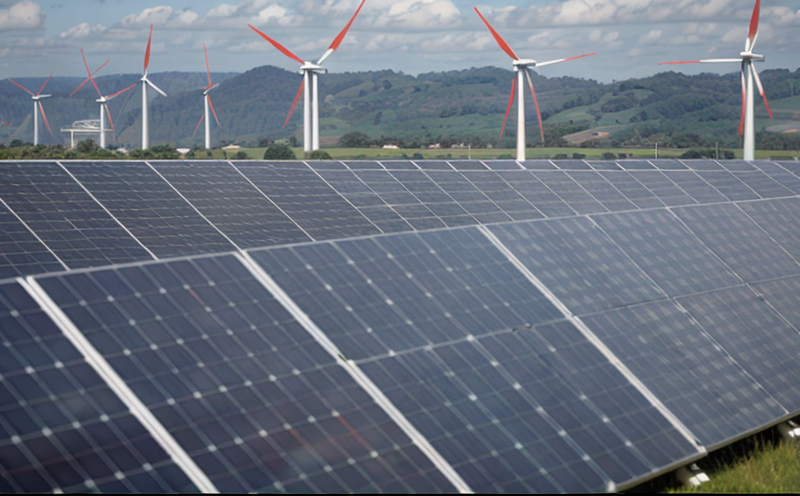Particle Size Distribution Analysis
In agriculture and forestry testing, particle size distribution analysis is a critical tool used to ensure the quality, performance, and safety of renewable energy systems. This service plays a pivotal role in optimizing the efficiency and longevity of biomass-based power generation processes. The primary focus is on assessing the fine particles that are essential components in various applications such as biofuels, biopower, and other renewable resources.
The process involves detailed characterization of the particle size distribution within materials used in these systems. This analysis helps in understanding how different particle sizes contribute to overall system performance. For instance, in biomass combustion processes, smaller particles can lead to higher combustion efficiency but also increased ash content. By analyzing the particle size distribution, quality managers and compliance officers can ensure that the material meets specific standards and specifications.
The instrumentation used for this analysis typically includes laser diffraction instruments, sedimentation-based methods, or sieving techniques, depending on the required level of precision. These tools provide precise measurements necessary to tailor the processes in a renewable energy system effectively. The acceptance criteria often align with international standards such as ISO 13320 and ASTM D5837.
Understanding particle size distribution is crucial for optimizing fuel properties, reducing emissions, and enhancing overall process efficiency. For R&D engineers, this service offers valuable insights into how different particle sizes can influence the performance of renewable energy systems. Procurement teams can leverage this information to select suppliers who provide materials that meet stringent quality standards.
The accuracy and reliability of these analyses are paramount in ensuring compliance with regulatory requirements and industry best practices. By providing detailed reports based on rigorous testing, we support our clients in making informed decisions that enhance the sustainability and efficiency of their operations.
Benefits
The benefits of particle size distribution analysis extend across various aspects of renewable energy systems, particularly in agriculture and forestry. Accurate knowledge of particle sizes helps in optimizing fuel properties, which directly impacts the efficiency and emissions profile of biomass-based power generation processes.
One significant benefit is the improvement in combustion efficiency. By ensuring that the particles are within acceptable size ranges, it is possible to achieve higher energy output while minimizing waste. This not only enhances operational performance but also contributes positively to environmental sustainability goals. Additionally, understanding particle distribution aids in reducing harmful emissions by optimizing fuel composition.
Another key advantage lies in enhancing process efficiency and longevity. Smaller particles can lead to faster reactions and better heat transfer properties, which are vital for efficient energy conversion processes. This optimization extends the operational lifespan of equipment used in these systems, thereby reducing maintenance costs and downtime.
From a regulatory perspective, compliance with industry standards is crucial. Accurate particle size distribution analysis ensures that materials meet specified criteria set by international bodies like ISO and ASTM. Compliance not only avoids penalties but also builds trust among stakeholders, including regulators and consumers.
The insights gained from this service can be instrumental in R&D initiatives aimed at developing new technologies or improving existing processes. By providing detailed reports based on comprehensive testing, it enables informed decision-making that supports innovation and advancement within the sector.
Industry Applications
The application of particle size distribution analysis in agriculture and forestry extends into several key areas where renewable energy systems play a significant role. One major application is in biofuel production, particularly for second-generation biofuels derived from lignocellulosic biomass. Understanding the particle size distribution helps optimize pretreatment processes to improve enzymatic hydrolysis efficiency.
In biopower generation, accurate knowledge of particle sizes ensures optimal combustion performance. This includes enhancing heat transfer rates and minimizing fouling within boilers or gasifiers. By tailoring fuel composition based on precise particle size analysis, operators can achieve higher thermal efficiencies while reducing emissions.
The sector also benefits from this service in waste management practices related to biomass utilization. Proper characterization of waste streams allows for better sorting and preprocessing steps, leading to improved resource recovery rates and reduced landfill contributions.
Moreover, particle size distribution analysis supports agricultural research focused on sustainable farming practices that integrate renewable energy technologies into daily operations. Farmers can use this information to select appropriate crop residues or other feedstocks suitable for conversion into bioenergy products.
Use Cases and Application Examples
| Use Case | Description |
|---|---|
| Biomass Pretreatment Optimization | Detailed particle size analysis guides effective pretreatment methods, enhancing enzymatic hydrolysis efficiency. |
| Combustion Efficiency Improvement | Precise characterization ensures optimal combustion performance in boilers or gasifiers. |
| Resource Recovery Enhancement | Analyzing waste streams helps improve sorting and preprocessing steps, maximizing resource recovery rates. |
| Fuel Composition Tailoring | Based on particle size distribution data, operators can optimize fuel composition for higher thermal efficiency and reduced emissions. |
| Sustainable Farming Practices | Selecting appropriate feedstocks for bioenergy production based on precise characterization. |
| Emission Reduction Strategies | Optimized particle sizes contribute to lower emission profiles, supporting environmental sustainability goals. |
| Boiler and Gasifier Performance Enhancement | Improved heat transfer rates and reduced fouling within boilers or gasifiers through tailored fuel composition. |
| Biofuel Production Optimization | Precise analysis ensures efficient conversion of lignocellulosic biomass into biofuels. |





